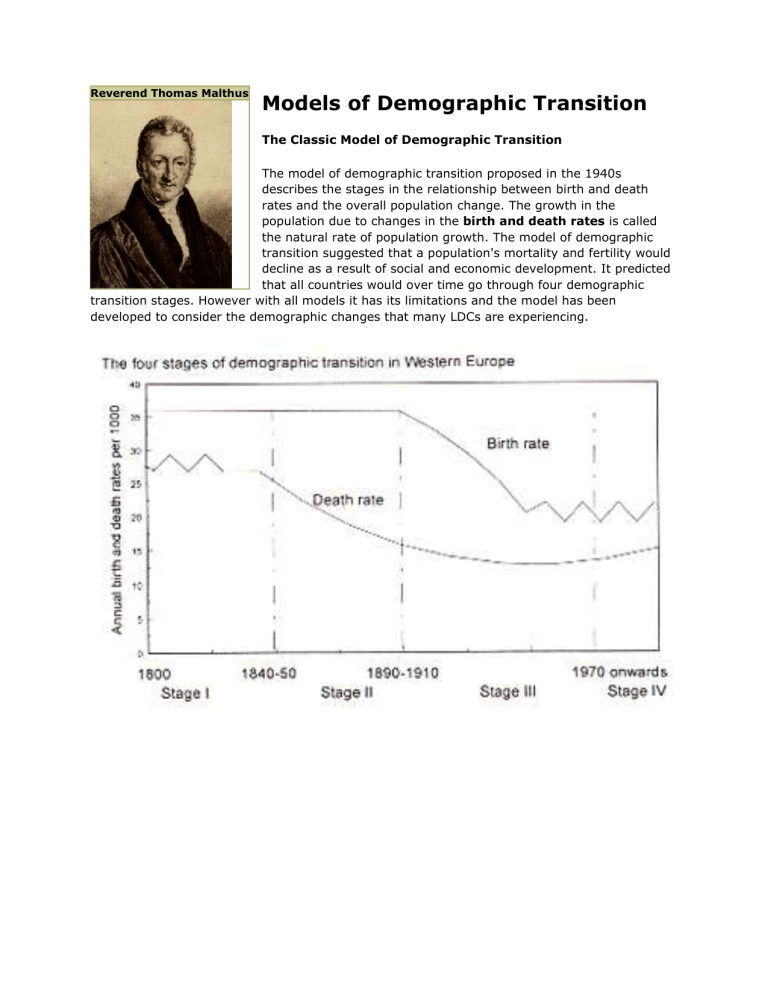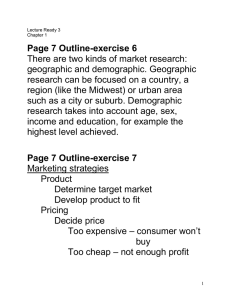Models of Demographic Transition

Reverend Thomas Malthus
Models of Demographic Transition
The Classic Model of Demographic Transition
The model of demographic transition proposed in the 1940s describes the stages in the relationship between birth and death rates and the overall population change. The growth in the population due to changes in the birth and death rates is called the natural rate of population growth. The model of demographic transition suggested that a population's mortality and fertility would decline as a result of social and economic development. It predicted that all countries would over time go through four demographic transition stages. However with all models it has its limitations and the model has been developed to consider the demographic changes that many LDCs are experiencing.
The tables below summarise the factors affecting birth rates and death rates in each stage
Stage 1 : Pre industrialisation: Stable population growth
High Birth rates
High Death Rates
Disease and plague (e.g. bubonic, cholera, kwashiorkor)
Famine , uncertain food supplies and poor diet
Poor hygiene, no piped clean water or sewage disposal
Stage 2: Rapid population growth
No or little Family
Planning
Parents have many children because few survive
Many children are needed to work the land
Children are a sign of virility
Some religious beliefs and cultural traditions encourage large families
High Birth rates
As stage 1
Falling Death Rates
Improved medical care e.g. vaccinations , hospitals, doctors, new drugs and scientific inventions
Improved sanitation and waters supply
Improvements in food production in terms of quality and quantity
Improved transport to move food and doctors
A decrease in child mortality
As stage 2
Stage 3: Continued and decreasing population growth
Falling Birth rates
Family Planning utilised , contraceptives, abortions, sterilisation and other government incentives
A lower infant mortality rates means less pressure to have children
Increased mechanisation and industrialisation means less need for labour
Increased desire for material possessions and less desire for large families
Emancipation of women
Death rates Low
Stage 4: Stable low population growth
Low Birth rates
Death rates
Low
The model predicts that eventually industrialised countries will have low stable population growth.
Demographic transition in LDCs
If we examine the economy of Zambia it could be argued that they have moved through stage 1 and stage 2. There is also some evidence of a decline in the birth rate, characteristic of stage three, however there are certain fundamental differences between population growth in MDCs and LDCs.
The Birth and Death rates in stage 1 are higher in LDCs that in MDCs
Stage 2 seems to have taken a much shorter time that it took with the MDCs
These two features have been included in a demographic transition model for LDCs by Berelson
Berelson suggests that
There are 3 clear stages rather than 4.
LDCs fall into two categories, Type A and Type B.
Type A countries are those that have experienced economic development and have seen a fall in their birth rate together with a decline in their death rate in Stage 3. Type B countries, typical of many low income LDCs such as Zambia have maintained a high birth rate with a death rate that is levelling off albeit at a higher rate than Type A countries.
Observation of mortality rate statistics in Zambia suggests that the death rate is starting to increase. The Aids epidemic and the worsening poverty are taking their toll.




